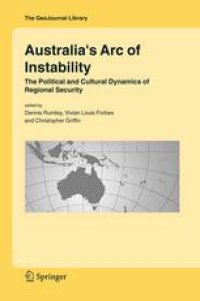
Ebook: Australia’s Arc of Instability: The Political and Cultural Dynamics of Regional Security
- Tags: Human Geography
- Series: The GeoJournal Library 82
- Year: 2006
- Publisher: Springer Netherlands
- Edition: 1
- Language: English
- pdf
The idea for this book emerged from a conversation between Vivian Forbes and Charles Eaton following two seminars held in the Department of Geography at the University of Western Australia given by Trevor So?eld and Christopher Grif?n more than ?ve years ago. One seminar involved papers from Charles Eaton and Christopher Grif?n on the recent Speight coup in Fiji; the other, given by Trevor So?eld, was on the Solomon Islands. The seminars were attended by, among others, Dennis Rumley, who on getting involved in the conversation, suggested the idea of a book and then followed through on its scope, structure, planning, and possible contributors. Looking back now, we owe a special debt of gratitude to Charles Eaton both for his enthusiasm and his ideas then, and for his continued support throughout the whole project. Since that time ?ve years ago, many people have boarded and have left the Arc. Indeed, the very project itself exhibited a degree of instability. At times, it even looked as though it might not stay a?oat. Thankfully, several early boarders remained ?rmly anchored. Other authors were co-opted later, some at relatively short notice, one or two of them under mild duress. We extend our heartfelt thanks to all of these contributors for remaining patient, enthusiastic, and keeping faith with the project. Naturally, a project like this, dealing with such a large and dynamic region, will always be out-of-date.
This book is unique in that it is the first multidisciplinary attempt to critically evaluate the oft-quoted arc of instability both conceptually and in terms of a series of themes and case studies from regional experts. It is of particular interest to specialists in foreign affairs, international relations and political geography, especially in Southeast Asia and Australia and the Southwest Pacific.
The aim of this book is to describe, discuss and evaluate the causes and likely implications of the contested notion of an emergent arc of instability for Australia and its region. The increasing importance of non-traditional security threats since the end of the Cold War has engendered a regional geopolitical transformation in the character of Australia’s region of primary strategic interest to one of perceived instability on the part of the Australian government. Since the nature of the main security threats has shifted away from traditional state-based to non-state-based threats, this has some fundamental implications both for regional relations and for the structure and conduct of Australian regional security policy.
All of the states and territories considered in the book have several things in common. Most are post-colonial states or state territories whose histories and social, economic and political structures raise concerns about their capacity to effectively deal with internal conflicts and, in some cases, possible external hostilities or blandishments. Indeed, some of these states exhibit a significant degree of ODA dependence, which, in turn, gives Australia considerable political influence in their affairs.
The book demonstrates that the nature and degree of instability, the way it is locally perceived, the differential relevance of some of its causes and the capacity of states to manage conflict varies considerably among the various case studies. It raises a wide range of issues and questions which are relevant for all regional policy-makers with an interest in maintaining regional stability. It offers suggestions for further research on a wide range of regional issues.